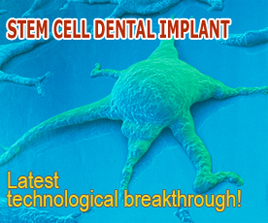|
|
Stem Cell Dental Implant

Dr. Lem is the only dental surgeon in the San Gabriel Valley who performs stem cell dental implant. A bone graft is necessary when the jaw bone is insufficient to support an implant.
Stem Cell grafting is the latest technology in helping bone to grow in deficient parts of the jaw. Stem cells are special cells that are found in the marrow of “flat” bones such as the hip or chest. The stem cells have the ability to multiply and become other tissue such as bone, cartilage, hair or skin. Stem cells are gathered by needle aspiration from the hipbone and placed against the jawbone. In four months, the stem cells “know” how to change into bone and make the region suitable for dental implants. The use of stem cells is revolutionary because the patient’s own live cells are used to create bone.
Other dental offices mainly use freeze-dried powder bone (cow bone, artificial bone and other people's bone) but powders alone do not have any “live” cells and are less likely to result in bone.
Tibial Bone Marrow
Another bone grafting option is to take bone from the tibia, or the area right below the knee. This technique obtains large amounts of the patient's own bone marrow to reconstruct areas of missing jaw bone. This is truly the gold standard because it works even in the most difficult cases and can be done as an office procedure. It is slightly more invasive than the stem cell bone graft and recovery tends to be longer but Dr. Lem has no reported cases of tibia bone failure.
|
|

News & Events
|
Stem cells are cells found in most, if not all, multi-cellular organisms. They are characterized by the ability to renew themselves through mitotic cell division and differentiating into a diverse range of specialized cell types.
|
|
A research suggests that coating dental implants with a synthetic bone material prior to implantation allows such implant to become incorporated much more successfully into the jaw, leading to smiles all round.
|
|
The results of experiments that focused on 'nanostructures'demonstrated enhanced bone response to dental implants as soon as 4 weeks after implant placement.
|
Newsletter
|